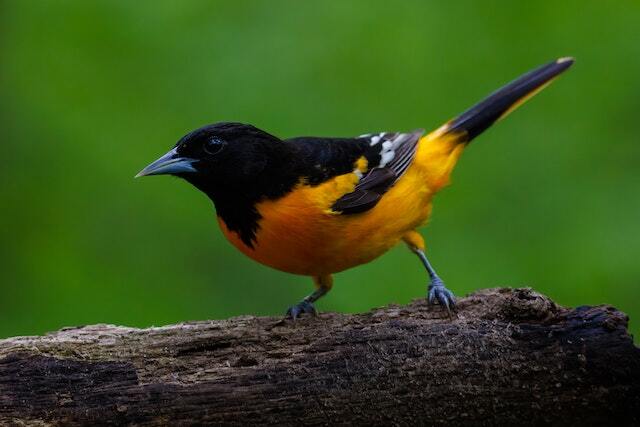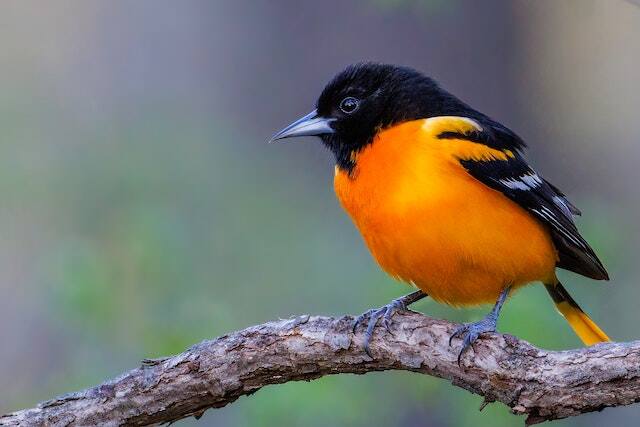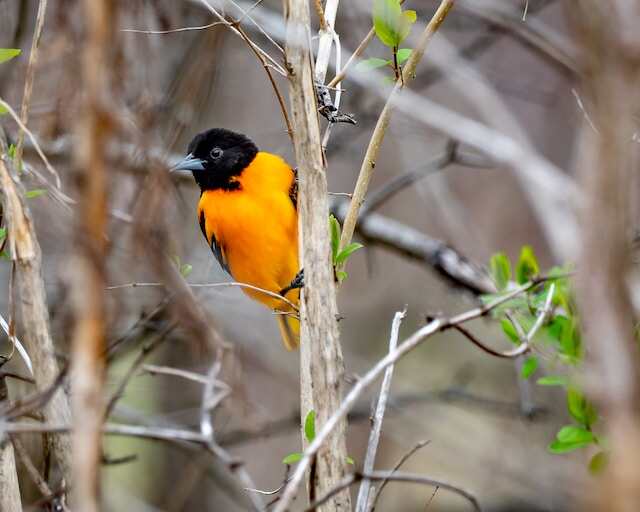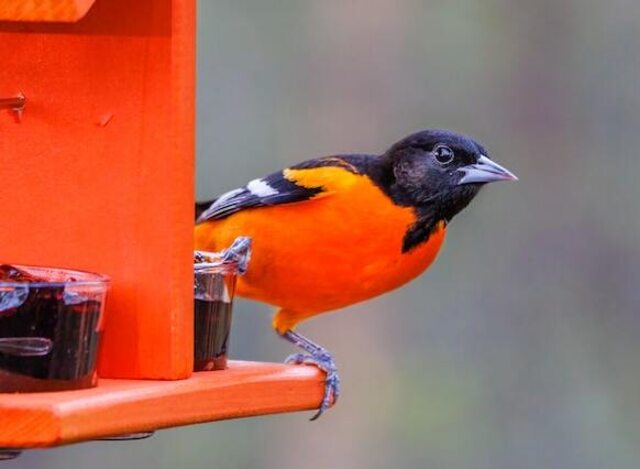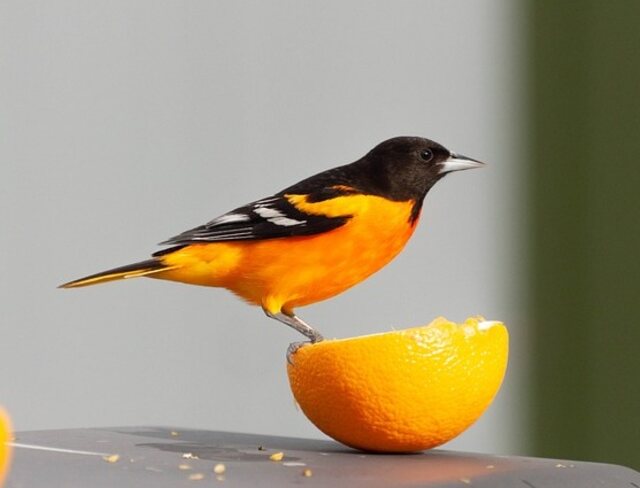Baltimore Orioles are beautiful birds that are a common sight in many backyards during the spring and summer months. These birds are known for their bright orange plumage and sweet, melodic songs.
While many people enjoy watching these birds and providing food for them, there is some confusion about what exactly Baltimore Orioles like to eat.
In particular, many bird enthusiasts wonder if these birds eat suet, a popular bird food made from animal fat.
Suet is a high-energy food that is beloved by many backyard birds, but it is not clear whether Baltimore Orioles eat it.
Some birders report seeing Orioles at suet feeders, while others say that these birds prefer other types of food.
In this article, we will explore the diet of Baltimore Orioles and investigate whether they are likely to eat suet.
We will also discuss other food options that may be more appealing to these birds, as well as tips for attracting Orioles to your backyard.
Table of Contents
- 1 Do Baltimore Orioles Eat Suet?
- 2 Understanding the Diet of Baltimore Orioles
- 3 Exploring the Appeal of Suet for Backyard Birds
- 4 Observing Baltimore Orioles and Suet Consumption
- 5 Alternative Food Choices for Baltimore Orioles
- 6 Tips for Attracting Baltimore Orioles to Your Backyard
- 7 Frequently Asked Questions
- 8 Do Baltimore Orioles eat peanut butter suet?
- 9 Conclusion
- 10 Author
Do Baltimore Orioles Eat Suet?
Baltimore Orioles do not typically eat suet, as their primary food sources are insects and fruit. However, they may occasionally consume suet if no other food sources are available or if it is offered as a supplement in bird feeders. Overall, suet is not a significant part of their diet.
Understanding the Diet of Baltimore Orioles
Understanding the diet of Baltimore Orioles involves knowing what they prefer to consume. These birds have a unique diet that consists mostly of insects, fruits, and nectar.
Orioles are known to be fond of caterpillars, beetles, and spiders, which they hunt by hovering in the air or perching on a branch.
They also enjoy eating fruits such as oranges, grapes, and berries, especially during the summer months when they are ripe and abundant.
Apart from insects and fruits, Baltimore Orioles are also attracted to nectar, which they obtain from flowers. They have a long, slender beak that allows them to reach the nectar deep inside the flower.
Orioles are commonly seen visiting hummingbird feeders that contain sugar-water, which serves as a substitute for natural nectar.
Overall, the diet of Baltimore Orioles is diverse and adaptable, which enables them to survive in various habitats. While they may occasionally consume suet, it is not a significant part of their diet.
Exploring the Appeal of Suet for Backyard Birds
You’ll love how suet attracts a variety of beautiful birds to your backyard, making it a prime spot for bird watching.
Suet is a high-energy food made from beef fat and mixed with various ingredients such as seeds, fruits, and insects.
It is a popular choice among many backyard birds, including woodpeckers, nuthatches, chickadees, and even some species of thrushes.
One reason suet is so appealing to birds is its high fat content, providing them with the necessary energy to survive cold winters.
Additionally, suet is easy to digest, allowing birds to quickly absorb the nutrients they need. By offering suet in your backyard, you’ll attract a diverse range of birds, adding color and life to your outdoor space.
Observing Baltimore Orioles and Suet Consumption
Take a moment to watch as the vibrant Baltimore Orioles indulge in the high-energy suet, adding a pop of color to your backyard bird watching experience.
Baltimore Orioles are known for their love of fruit, but they also enjoy a variety of other foods, including suet.
Suet is a high-energy food made from animal fat and is commonly used to attract a variety of backyard birds, including woodpeckers, chickadees, nuthatches, and yes, even Baltimore Orioles.
When it comes to suet consumption, Baltimore Orioles are not as frequent visitors as other backyard birds.
They tend to prefer fresh fruit and nectar over suet, but that doesn’t mean they won’t indulge in a suet block every now and then.
When they do visit, they are a delight to watch as they cling to the suet feeder with their strong feet and use their sharp beaks to extract the energy-rich food.
So, if you want to attract Baltimore Orioles to your backyard, suet may not be your first choice, but it’s definitely worth a try.
Alternative Food Choices for Baltimore Orioles
If you’re looking for new ways to entice these colorful birds into your backyard, there are plenty of alternative food options to consider.
While suet is a popular choice for many bird species, Baltimore Orioles prefer a diet that is high in sugar. One option is to offer them nectar from a hummingbird feeder.
Simply mix four parts water with one part white granulated sugar and fill the feeder. Orioles will also enjoy fresh fruit such as oranges, grapes, and apples.
Cut the fruit into small pieces and place it on a platform feeder or skewer it to hang from a tree branch.
Another food option for Baltimore Orioles is mealworms. These can be offered in a small dish or on a platform feeder.
Mealworms are high in protein and a great source of nutrition for birds. Orioles may also enjoy jelly, which can be offered in a dish or on a platform feeder.
Just be sure to choose a jelly that is free of artificial sweeteners.
By offering these alternative food choices, you can attract Baltimore Orioles to your backyard and provide them with a variety of healthy and delicious meal options.
Tips for Attracting Baltimore Orioles to Your Backyard
To lure these vibrant birds to your yard, try offering nectar, fresh fruit, mealworms, and jelly as alternative food choices.
Baltimore Orioles are known to have a sweet tooth, so offering nectar and jelly can be particularly effective.
You can easily make your own nectar by mixing four parts water with one part granulated sugar. Make sure the sugar is dissolved completely before offering it to the birds.
Orioles are also attracted to oranges, grape jelly, and sliced bananas, so try offering these fruits as well.
It’s important to place these food items in a location that is easily visible to the birds and in a feeder that is accessible to their beaks.
Orioles prefer to feed at heights between 8–10 feet, so consider hanging the feeder from a tree branch or placing it on a shepherd’s hook.
Additionally, providing a source of fresh water, such as a birdbath or fountain, can also attract these beautiful birds to your yard.
By offering a variety of food and water sources, you can create a welcoming environment for Baltimore Orioles in your backyard.
Frequently Asked Questions
Do Baltimore Orioles eat peanut butter suet?
Yes, Baltimore Orioles have been known to eat suet that contains peanut butter. While suet is not a significant part of their diet, orioles may occasionally consume suet if it is offered as a supplement in bird feeders, including those that contain peanut butter mixed in.
Additionally, some backyard birders have reported seeing orioles feeding on suet with seeds during nesting season.
What is the average lifespan of a Baltimore Oriole?
The average lifespan of a Baltimore Oriole is around 8–10 years in the wild. These birds are known for their bright orange plumage and beautiful song, which makes them a popular bird to watch and listen to.
They typically feed on insects, fruit, and nectar, and can be found in deciduous forests, orchards, and gardens throughout the eastern United States.
While they may occasionally eat suet, it is not a significant part of their diet. Overall, the Baltimore Oriole is a beloved bird with a relatively long lifespan compared to other species.
How do Baltimore Orioles communicate with each other?
Baltimore Orioles are known to be highly social birds that communicate with each other in a variety of ways.
They use a combination of vocalizations, body language, and visual cues to convey information about their location, food sources, and potential threats.
For example, male orioles often use their bright plumage and elaborate songs to attract mates and defend their territory, while females may use a more subdued call to communicate with their young.
Overall, the complex communication system of Baltimore Orioles is an important part of their social behavior and helps them to thrive in their natural habitat.
What is the nesting behavior of Baltimore Orioles?
Baltimore Orioles are known for their intricate and unique nesting behavior. These birds build their nests high up in deciduous trees, using a variety of materials such as grasses, vines, and even hair or string.
The male oriole takes on the role of primary nest builder, while the female is responsible for lining the nest with soft materials such as feathers or plant down.
Baltimore Orioles are also known to weave their nests in a hanging basket-like shape, which helps to protect their eggs and young from predators.
This nesting behavior is just one of the fascinating aspects of these beautiful birds, without even considering whether they eat suet or not.
What is the migration pattern of Baltimore Orioles?
Baltimore Orioles are migratory birds that spend their winters in Central America and northern South America, and their summers in North America.
Their migration pattern typically takes them through the eastern United States and into Canada, where they mate and raise their young.
These birds are known for their bright orange plumage, and their unique nesting behavior. Orioles build intricate, hanging nests made from grasses, plant fibers, and other materials, usually from the branches of tall trees.
While they primarily feed on insects, fruits, and nectar, there is no evidence to suggest that Baltimore Orioles eat suet.
How do Baltimore Orioles adapt to different climates and environments?
Baltimore Orioles are known for their vibrant colors and beautiful song, but they are also impressive in their ability to adapt to different climates and environments.
These birds are found across a wide range of habitats, from forests and woodlands to suburban and urban areas.
In order to survive in these diverse environments, Baltimore Orioles have developed a number of adaptations.
For example, they are able to change their diets to suit the resources available in their environment.
They also have unique nesting habits, building their nests in a variety of locations, from tall trees to shrubs and even in hanging baskets.
Overall, Baltimore Orioles are a fascinating species that have managed to thrive in a wide range of settings.
Conclusion
Overall, while Baltimore Orioles are not known to regularly consume suet, it can still be a great addition to your backyard bird feeding station.
Suet can provide a high-energy food source for a variety of backyard birds and may attract more Orioles to your yard.
However, it is important to also provide alternative food choices such as fruit, nectar, and mealworms to ensure a well-rounded diet for these beautiful birds.
If you are hoping to attract Baltimore Orioles to your backyard, there are several key tips to keep in mind.
Providing a variety of food options and keeping your feeding station clean and well-maintained can make your yard a desirable location for these birds.
Additionally, planting native trees and shrubs can provide nesting sites and a natural food source for Orioles.
With a little effort and attention, you can create a welcoming environment for Baltimore Orioles and other backyard birds in your community.


